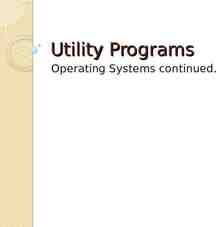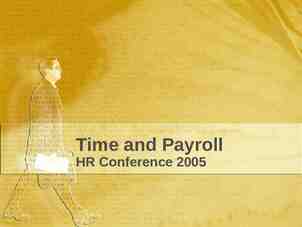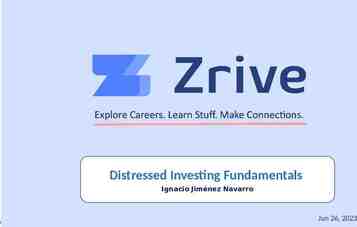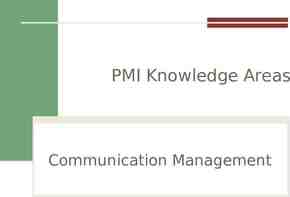2017 Performance Management Changes
36 Slides2.20 MB

2017 Performance Management Changes

Program Overview

Program Goals Make process clearer and less cumbersome Streamline/target content of performance plan Use of electronic system Create standardization for evaluations Define satisfactory level of work at “meeting expectations” for business needs Tie institutional goals to mission and vision of the University.

Program Goals Increase accuracy and defensibility of ratings Address both behavior and conduct Ensure position/performance management consistency Ensure ease of quality control and data analysis Promote open and clear communication

Evaluation Program – Current & Future Timelines Current (through March 31, 2017) Future (Beginning April 1, 2017) Performance Cycle April 1 – March 31 No change Performance Planning (Goal Setting & Calibration) Post-Evaluation Rating Calibration March - April March – April (with Calibration) N/A March – April Evaluations Completed April - May No Change

Evaluation Program – Current & Future Evaluation Structure Current (through March 31, 2017) Future (Beginning April 1, 2017) Core Work Values 5 Institutional Goals Job Duties 3-5 Individual Goals Professional Development One additional for supervisors Weighted 50% Set by supervisors Weighted 50% Talent Development Goal

Evaluation Program – Current and Future Types of Evaluations Current (through March 31, 2017) Future (beginning April 1, 2017) Probationary Due at 3 months Due Quarterly (January, April, July, October) Interim Due October November Required if employee has Disciplinary Action, is Not Meeting Expectations, if supervisor wants to, or if Chancellor/designee requires Transfer Due at time of Transfer Due at time of Transfer or if supervisor leaves Employee Requested Evaluations N/A Employees can request one off-cycle evaluation per performance cycle granted 60 days has passed since last evaluation Management Driven N/A Supervisors can conduct as often as they find necessary.

Evaluation Program – Current & Future Current (through March 31, 2017) Five-Point System Outstanding Exceeds Expectations Meets Expectations Below Expectations Unsatisfactory Final Ratings based on overall evaluation Comments Supervisors comment on each individual Core Work Value and Overall Performance Employees can include written comments Rating Future (beginning April 1, 2017) Three-Point System Exceeds Expectations Meets Expectations Below Expectations Final ratings based on weighting and final outcome One overall comments section No change

Evaluation Program Calibration Sessions Supervisory teams meet at beginning of cycle to set performance goals Supervisory teams meet at end of cycle to ensure consistency in performance ratings Required for Employees in Similar Positions Best practice for other positions

Evaluation Program Employee Records Retain documents for at least 3 years Hiring supervisors can review performance documents for final candidates Appeal Rights Final Overall Rating of “Not Meeting Expectations” Grievable to University level University SHRA Employee Grievance Policy

Institutional Goals

Institutional Goals EXPERTISE Precision Precision Resourcing Resourcing Innovation Innovation Development Development CUSTOMERORIENTED Clarity Awareness Attentiveness Diplomacy COMPLIANCE/ETHICS Policy Policy Safety Safety Ethics Ethics Respect Respect ACCOUNTABILITY Productivity Productivity Autonomy Autonomy Prioritization Prioritization Coordination Coordination TEAM-ORIENTED Collegiality Collaboration Contribution Attendance SUPERVISION SUPERVISION Oversight Oversight Goal-Setting Goal-Setting Managing Talent Talent Managing Leading Leading

Individual Goals

Individual Goals Working with employee, supervisor defines 3-5 individual goals for each employee each cycle. Not intended to cover all aspects of employee work product (institutional goals do that). Focus is on key results/outcomes/deliverables, not steps in the process.

Smart-er Goals S - Specific M - Measurable A - Achievable R - Relevant T - Time-bound E - Expectations R - Resources

Individual Goals Do this . Present the new Performance Management plan to all SHRA supervisors in order to . provide sufficient guidance to supervisors on new program so that . they will be ready to develop performance plans in 2017.

Structure of Goals Three things to keep in mind while preparing SMART-ER goals: 1. The Goal Itself 2. The Specific Deliverables 3. What “Exceeding Expectations” Looks Like.

Structure of Individual Goals Goal: Present the new PM plan to all SHRA supervisors before December 15, 2016 in order to provide sufficient guidance to supervisors on new program so that they will be ready to develop performance plans in 2017. Specific Deliverables: 1. Develop a PowerPoint presentation to be used by all involved. 2. Determine what handout materials are needed. Exceeding Expectations: Not only present new PM plan to all supervisors face-to-face but develop online Cornerstone training based off of face-to-face

Talent Development

Talent Development Recommended (not required) that each employee have at least ONE Talent Development Goal per cycle. Supervisor and employee work to determine appropriate goals Supervisor expected to address deficiencies of any employee who received any rating of “Not Meeting Expectations.”

Talent Development Some examples could include securing funding for a certification program, attending seminars provided by the University, etc.

Weighting and Rating

Weighting and Rating For Institutional Goals, the total for all must equal 50% Remember: “Supervision” is only applicable if the employee is a

Weighting and Rating 3-5 Individual Goals are required. We recommend 3 for the first cycle on the new PM program. The total for all Individual Goals must equal 50%

Weighting and Rate One thing to remember about weights They should not be changed at or near the end of a performance cycle unless due to significant extenuating circumstances.

Weighting and Rating Scoring Rate each Individual and Institutional Goal Add all of the Scores together to assign a Final Overall Rating 1 Not Meeting Expectations 1.00 – 1.69 Not Meeting Expectations 2 Meeting Expectations 1.70 - 2.69 Meeting Expectations 3 Exceeding Expectations 2.70 - 3.00 Exceeding Expectations Multiply the Weight by the Rating to get the Score for each goal. Use two decimal places. (Example: 10% x 2 .20)

Weighting and Rating Weight x Rating Score Add all of the scores from Institutional Goals and Individual Goals to calculate Total Score.

Calibration Discussions

Calibration Overview Discussions to set performance expectations and ratings fairly and consistently among similar positions. Sessions held among peer supervisors in a supervisory team (all supervisors reporting to same manager) Typically facilitated by the manager of the supervisory team

Calibration Overview Value of Calibration Helps supervisors set and apply similar standards Helps identify and correct potential biases or errors Encourages supervisors to think through expectations and ratings before giving them to employees Ensures consistency among departmental units

Calibration Overview Two discussions required per cycle Goal Calibration at the beginning of the performance cycle Reviewing institutional goals to clarify expectations Setting individual goals Rating Calibration at the end of the performance cycle to ensure consistent, equitable, and fair assessments among similar positions.

Calibration Timeline Both performance plans and annual appraisals need to be completed in the months of April and May Typically supervisory teams should be meeting in mid-tolate April to hold calibration discussions for both the Annual Appraisal and the upcoming year’s Performance Plan. These meetings are held before the supervisor can review the Annual Appraisal or the Performance Plan with the evaluated employee.

Goal Setting Calibration Pr ew ork Defin e Addit ional Reso urces Int rod uct Defi ion ne Indiv idual Goal s Sim ilar Posi tion Defin s e Weig hts for Goals Discu ss Instit ution al Discu Goals ss Talen t Devel opme nt

Rating Calibration Pr ew ork Int rod uct ion Discu ss Instit ution al Goals Review Final Overall Ratings Discu ss Indiv idual Goals

Justin Yeaman Christy Carraway Sara Lilley Jeff Buck Learning and Organizational Development 252-328-9848 [email protected] Employee Relations 252-328-9848 [email protected]







